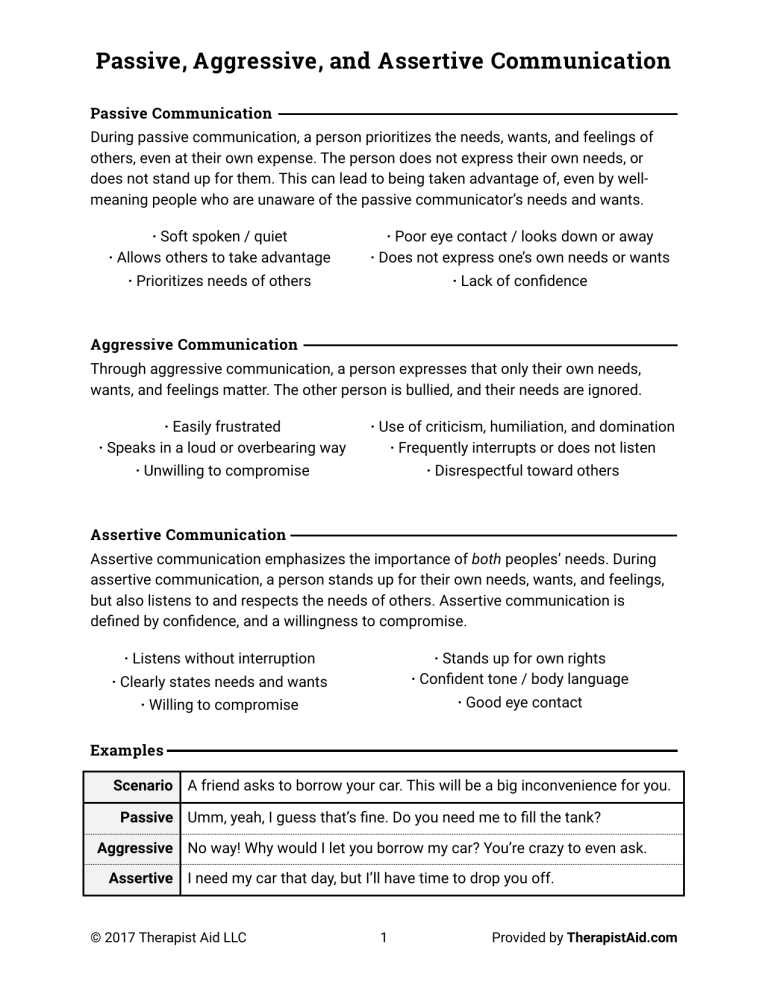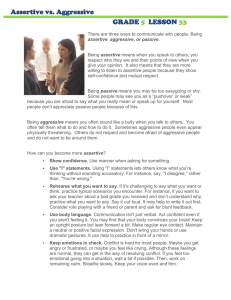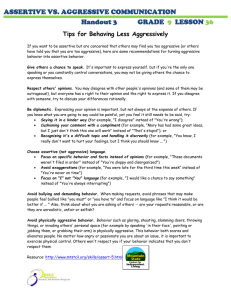
Passive, Aggressive, and Assertive Communication Passive Communication During passive communication, a person prioritizes the needs, wants, and feelings of others, even at their own expense. The person does not express their own needs, or does not stand up for them. This can lead to being taken advantage of, even by wellmeaning people who are unaware of the passive communicator’s needs and wants. · Soft spoken / quiet · Allows others to take advantage · Poor eye contact / looks down or away · Does not express one’s own needs or wants · Prioritizes needs of others · Lack of confidence Aggressive Communication Through aggressive communication, a person expresses that only their own needs, wants, and feelings matter. The other person is bullied, and their needs are ignored. · Easily frustrated · Speaks in a loud or overbearing way · Use of criticism, humiliation, and domination · Frequently interrupts or does not listen · Unwilling to compromise · Disrespectful toward others Assertive Communication Assertive communication emphasizes the importance of both peoples’ needs. During assertive communication, a person stands up for their own needs, wants, and feelings, but also listens to and respects the needs of others. Assertive communication is defined by confidence, and a willingness to compromise. · Listens without interruption · Clearly states needs and wants · Stands up for own rights · Confident tone / body language · Willing to compromise · Good eye contact Examples Scenario A friend asks to borrow your car. This will be a big inconvenience for you. Passive Umm, yeah, I guess that’s fine. Do you need me to fill the tank? Aggressive No way! Why would I let you borrow my car? You’re crazy to even ask. Assertive I need my car that day, but I’ll have time to drop you off. © 2017 Therapist Aid LLC 1 Provided by TherapistAid.com Passive, Aggressive, and Assertive Communication Practice Scenario Your boss asks you to stay late, while everyone else leaves. You’re always the one who stays late, and tonight you have plans. Passive Aggressive Assertive Scenario Your partner left a mess in the kitchen, and you’re too busy to clean. Passive Aggressive Assertive Scenario You’re at a restaurant, and the server brought you the wrong dish. Passive Aggressive Assertive Scenario A friend showed up at your house uninvited. Usually you would be happy to let them in, but this time you’re busy. Passive Aggressive Assertive © 2017 Therapist Aid LLC 2 Provided by TherapistAid.com




